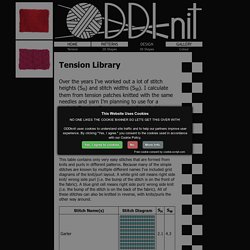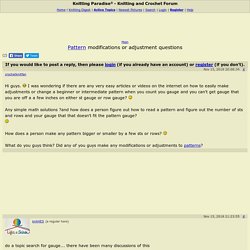

More Thoughts On Gauge. OYWTM. Binka Schwan. May Jul 2010. The Mathematics of Knitting, Part 1: Gauge and Aspect Ratio - knitting.today. Do you knit?

Can you explain gauge? And how the heck are we supposed to know how many stitches we need to cast on to achieve a specific target width? Looking at my frequently asked questions there are a lot of open questions related to calculations, so let’s talk about the mathematics of knitting this month! Today, I’m going to share my thoughts on the first big topic of mathematics in knitting with you: Knitting gauge and aspect ratio. (Don’t run away now!
For everybody (or at least, most of us) math classes were not the most popular in school. But … Knitting Needs Mathematics. If you’re a knitter who loves to follow patterns created by others you don’t need to be involved in the underlying math problems. Well, there are a lot of things that can go wrong – even then. My first attempt to knit a sweater without checking gauge first ended up in something my husband could wear instead. What went wrong? I didn’t check gauge first. What good is gauge? How to Fix Gap Between the Rows. You’ve seen it.

It’s especially visible on the wrong side of stockinette stitch. I’m talking about the gap that happens between every two rows. Some knitters say that this gap is a minor imperfection that confirms that their project is handmade. Others try to avoid stockinette stitch altogether (I know, I did…). It’s not that this gap is bad and ruins the look of the project. If you do want to improve the look of the fabric and to get rid of that gap, I’ll show you two ways to do it. First, let’s understand why the gap happens. That’s why it never happens when we work in stockinette stitch in the round. Usually, we tend to make the purl row looser than the knit one, but it may not be true for your personal style. To find out which row is looser in YOUR knitting, take the same kind of yarn in two solid colours.
Cast on about 20 stitches and work in stockinette stitch (knit one row and purl the other one) changing colour in every other row for about 20 rows. Thank you for reading this far. Simple Way to Make Sure Your Gauge is Correct - cairnsjenn - Gmail. - Tension - Stitch Height and Width Library. Over the years I've worked out a lot of stitch heights (SH) and stitch widths (SW).

I calculate them from tension patches knitted with the same needles and yarn I'm planning to use for a project. Because I'm a creature of habit, this often means I'm using dk yarn and 3.25mm needles. Below is a library I'm compiling of the results I get for these specific needles and this specific yarn. This table contains only very easy stitches that are formed from knits and purls in different patterns. Because many of the simple stitches are known by multiple different names I've included grid diagrams of the knit/purl layout. *Stitches are measured in their relaxed state. . © 2016 All desgins and images are copyright of ODDknit. What to Do If Your Knitting Tension Is Too Tight, Too Loose or Uneven - cairnsjenn - Gmail.
Simple Way to Make Sure Your Gauge is Correct - cairnsjenn - Gmail. Pattern modifications or adjustment questions. Pattern modifications or adjustment questions Hi guys.

I was wondering if there are any very easy articles or videos on the internet on how to easily make adjustments or change a beginner or intermediate pattern when you count you gauge and you can't get gauge that you are off a a few inches on either st gauge or row gauge? Any simple math solutions ? And how does a person figure out how to read a pattern and figure out the number of sts and rows and your gauge that that doesn't fit the pattern gauge? How does a person make any pattern bigger or smaller by a few sts or rows? What do you guys think? Do a topic search for gauge... there have been many discussions of thisThere is a process, but it takes several steps to do.
Most of time I see people recommend these 2 things:1) keep changing needle size until you achieve the gauge (number of stitches in 4 inches) that the pattern specifies2) Choose a different pattern that uses the gauge you are able to make. Row gauge is less important.